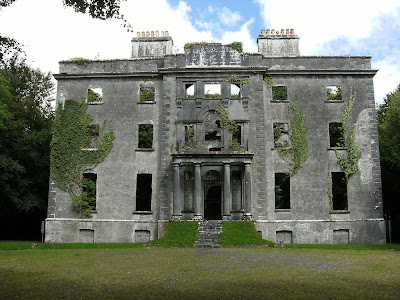THOMAS MORE, born at Chilston, near Madley, in Herefordshire, married Mary, daughter of John ApAdam, of Flint, and had a son,
GEORGE MOORE, who settled at Ballina, County Mayo, Vice-Admiral of Connaught during the reign of WILLIAM III.
He wedded Catherine, daughter of Robert Maxwell, of Castle Tealing, Scotland, by Edith his wife, daughter of Sir John Dunbar, and was father of
MOORE HALL, near Ballyglass, County Mayo, is a Georgian mansion built between 1792-6 by George Moore.
Colonel Moore's elder brother, George Augustus Moore, died in 1933, leaving an estate valued at £70,000 (about £5.1 million in 2021).
GEORGE MOORE, of Ashbrook, County Mayo, living in 1717, who married Sarah, daughter of the Rev John Price, of Foxford, County Mayo, by his wife, Edith Machen, of the city of Gloucester, and by her had two sons,
George, of Cloongee;JOHN, of whom we treat.
The younger son,
JOHN MOORE, of Ashbrook, County Mayo, born ca 1700, espoused Jane, daughter of Edmund Athy, and had issue,
Robert, dsp 1783;GEORGE, of whom presently;Edmund, of Moorbrook;Sarah; Jane.
His second son,
GEORGE MOORE (1729-99), of Moore Hall, Ashbrook, and Alicante, Spain, married, ca 1765, Catherine, daughter of Dominick de Killikelly, of Lydacan Castle, County Galway, and had issue,
John, 1763-99;GEORGE, of whom hereafter;Thomas;Peter.
The second son,
GEORGE MOORE (1770-1840), of Moore Hall, wedded, in 1807, Louisa, daughter of the Hon John Browne, sixth son of John, 1st Earl of Altamont, and had issue,
GEORGE HENRY, his heir;John;Arthur Augustus.
The eldest son,
GEORGE HENRY MOORE JP DL (1810-70), MP for County Mayo, 1847-57, 1868-70, High Sheriff of County Mayo, 1867, espoused, in 1851, Mary, eldest daughter of Maurice Blake, of Ballinafad, County Mayo, and had issue,
GEORGE AUGUSTUS, his heir;Maurice George, CB, Colonel, Connaught Rangers;Augustus George Martin;Henry Julian;Nina Mary Louisa.
He was succeeded by his eldest son,
GEORGE AUGUSTUS MOORE (1852-1933), of Moore Hall and Ebury Street, London, High Sheriff of County Mayo, 1905, who died unmarried.
THE MOORES had originally been an English Protestant settler family.
The father of George Moore (1729-99), John Moore, converted to catholicism when he married Jane Lynch Athy from one of the principal Catholic families in County Galway.
Using her connections among the "Wild Geese," Irish Jacobite exiles in Spain, Jane supported her son in getting established in the wine import business in Alicante, Spain.
He subsequently changed his religion, and married, in I765, Katherine de Kilikelly, an Irish Catholic raised in Spain.
George made his fortune and returned to erect Moore Hall in 1792, above the shore of Lough Carra.
"He thus solidified the shift of the family from being New English settlers of Protestant faith to their nineteenth-century identity as Irish Catholic landlords who had never been humbled by the "Penal Laws" — that set of regulations aimed at limiting the property and power of Irish Catholics, and put in force after William of Orange routed James II at the Battle of the Boyne in 1688.""The change in the confessional identity of the Moore family, like the circumstances of G H Moore's death, is important to the story of George Moore. These matters would one day be the occasion of a quarrel about family history that broke up the surviving Moore brothers, saw Moore Hall become vacant, and scattered the last generation of Moores abroad.""Of the four sons of George Moore of Alicante, the eldest was John Moore (1763-99), a scapegrace trained in Paris and London for the law, and for a few days in 1798 the first President of the Republic of Connaught.""Aided by French invaders at Killala, John Moore participated in the surprise victory of General Humbert over a British garrison at Castlebar on 27 August 1798, assumed nominal leadership of the rebels, then got captured after the rout of the small Irish forces.""President Moore died while under house arrest in a Waterford tavern. The second son of Moore of Alicante was a mild-tempered man, also named George Moore. A gentleman scholar rarely out of his library, he wrote histories of the English and French revolution, something in the manner of Gibbon.""Moore the historian had three sons by Louisa Browne, the first being George Henry Moore, the only one of the three not to die by a fall from a horse."
 |
| Moore Hall (Image: Robert French) |
MOORE HALL, near Ballyglass, County Mayo, is a Georgian mansion built between 1792-6 by George Moore.
It comprises three storeys over a basement, with an entrance front of two bays on either side of a centre breakfront; including a triple window, and fluted pilasters on console brackets.
There is a Venetian window above the entrance doorway, beneath a single-storey Doric portico.
The house was burnt by the IRA in 1923, and is now a ruinous shell.
Colonel Maurice Moore, CB, had intended to rebuild the house, albeit on a smaller scale.
 |
| Moore Hall (Image: Comhar - Own work, Public Domain, https://commons.wikimedia.org/w/index.php?curid=11252115 |
Colonel Moore's elder brother, George Augustus Moore, died in 1933, leaving an estate valued at £70,000 (about £5.1 million in 2021).
His ashes were buried on Castle Island in Lough Carra.




2 comments :
It saddens me to see a house like that in ruins.
The house and lands have now been acquired by Mayo County Council and there is a development plan for the restoration of the house with work already underway on the walled garden. This is a long term plan which will require major investment.
Post a Comment